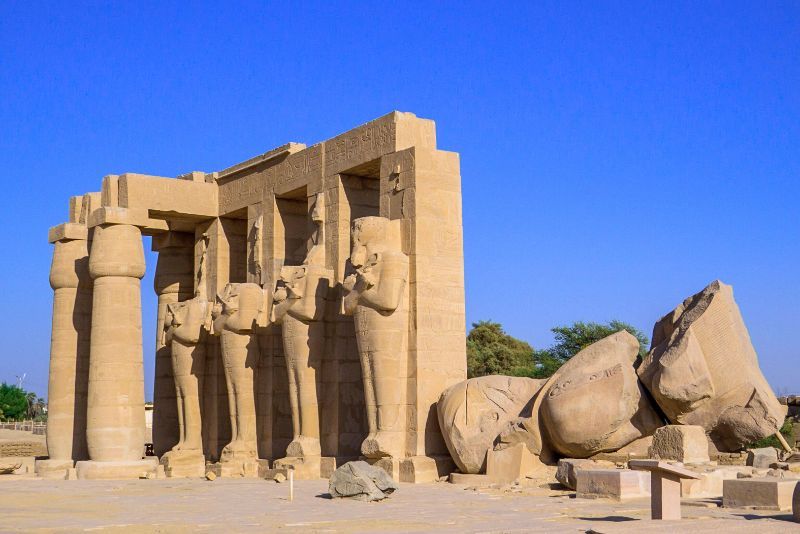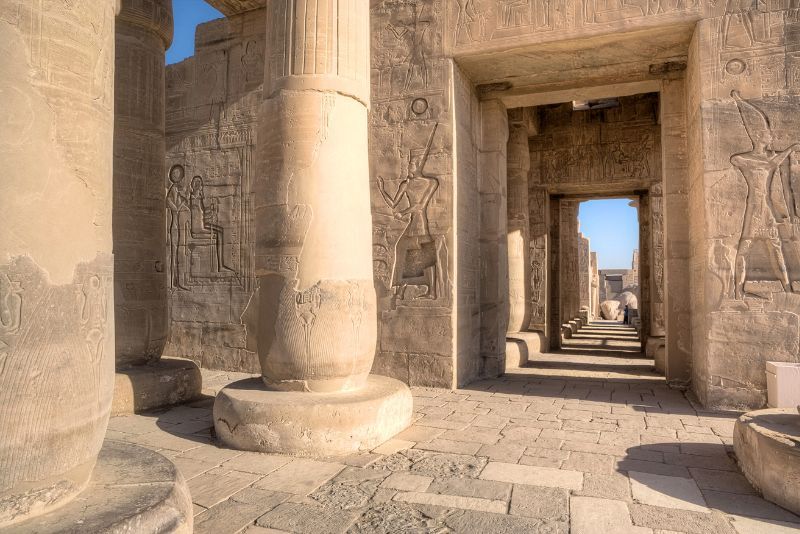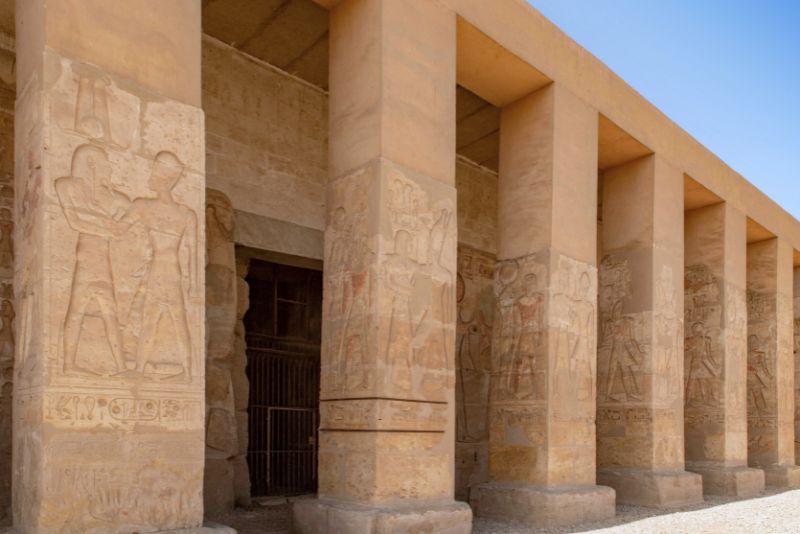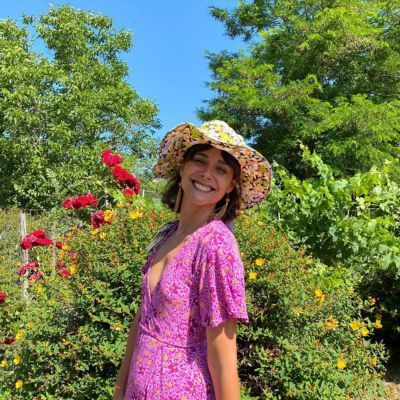Ramesseum Temple: Tickets and Tours
Hoping to secure a comfortable afterlife and leave a glittering legacy, Egyptian pharaohs put unimaginable amounts of energy and wealth into building themselves impressive tombs. With each king striving to outdo his predecessors, pharaohs drew up grandiose plans and put them to action right from the beginning of their reigns.
Ramesses the Great made sure that stories of his power would live on. Ramesseum, his hulking mausoleum, is a display of the pharaoh’s greatness. With Ramesseum Temple tickets, you will be able to glimpse the towering columns, crumbling statues and well-preserved depictions that honor this ancient king.
Hoping to secure a comfortable afterlife and leave a glittering legacy, Egyptian pharaohs put unimaginable amounts of energy and wealth into building themselves impressive tombs. With each king striving to outdo his predecessors, pharaohs drew up grandiose plans and put them to action right from the beginning of their reigns.
Ramesses the Great made sure that stories of his power would live on. Ramesseum, his hulking mausoleum, is a display of the pharaoh’s greatness. With Ramesseum Temple tickets, you will be able to glimpse the towering columns, crumbling statues and well-preserved depictions that honor this ancient king.

(0/24) checking Musement...
Hoping to secure a comfortable afterlife and leave a glittering legacy, Egyptian pharaohs put unimaginable amounts of energy and wealth into building themselves impressive tombs. With each king striving to outdo his predecessors, pharaohs drew up grandiose plans and put them to action right from the beginning of their reigns.
Ramesses the Great made sure that stories of his power would live on. Ramesseum, his hulking mausoleum, is a display of the pharaoh’s greatness. With Ramesseum Temple tickets, you will be able to glimpse the towering columns, crumbling statues and well-preserved depictions that honor this ancient king.

Here's all you need to know about visiting the Ramesseum Temple, one of the most incredible attractions in Luxor.
How much do Ramesseum Temple tickets cost?
Adult tickets for the Ramesseum cost around EGP60 (approximately US$2) per person. Prices tend to fluctuate, so come prepared with cash in Egyptian pounds in case of a change in cost.
Who is eligible for discounts?
Children aged 6 to 12 and students with an International Student Identification Card are eligible for half-price tickets at EGP30 (US$1) per person.
Should you book in advance?
Tickets and tours to the Ramesseum are unlikely to sell out, but booking ahead of time is wise. Plan your outing for the morning to avoid the most intense heat of the day.
What are the best Ramesseum Temple tours?

A private tour to the Ramesseum is a worry-free way to reach the temple. Benefit from an Egyptologist guide who provides round trip transportation from your Luxor hotel or cruise dock.
These wheelchair-friendly tours provide you with bottled water and air conditioned transportation. Absorb the mind-boggling history of Ramesses II’s mortuary temple as a guide answers your every question.
Private tours allow you flexibility to spend more or less time at certain spots and can lead groups of up to 8 to 15 people. Tours last around 4 hours with a 40-minute drive each way between the temple and Luxor and cost around US$25 per person.
Do note that many Ramesseum guided tours do not include entrance fees to the temple.
Are there any combined tickets or tours including the Ramesseum Temple and other attractions?
Luxor’s West Bank is a vast archeological treasure trove. Most tours help you take advantage of more than just the Ramesseum on your adventure across the Nile. Egyptologist guides escort you on private excursions to two or more lesser-known West Bank attractions with round-trip transportation from Luxor.
Ramesseum plus Carter House tours
Wander the Temple of Ramesses followed by a visit to Carter House. The former home of British explorer Howard Carter, discoverer of the tomb of Tutankhaman, is now a museum.
View the tools he and his team used to excavate the site as well as work spaces where they studied their findings. In the house's garden sits a replica of Tutankhaman’s tomb.
Ramesseum plus Deir el Bahari and Deir el Medina tours
In a three-stop tour, see Ramesseum and two other mortuary sites. Deir el Bahari is the monument to Queen Hatshepsut, Egypt’s only female pharaoh who reigned for 20 years. Deir el Medina, or the “Valley of the Artisans,” shelters the remains of the skilled craftspeople who constructed tombs for the nobles.
Ramesseum plus Valley of the Nobles and Deir el Medina tours
Take in monuments to the wealthy and powerful as well as the tireless laborers whose work is immortalized in the West Bank.
Ramesseum plus Valley of the Nobles and Habu Temples tours
These three-stop tours usher you to the tombs of great Egyptians as well as the palace and temples of Medinat Habu.
Ramesseum plus Valley of the Queens, Carter House and Temple of Seti tours

Fill a day with visits to the temples of Ramesses, Queen Nefertari and Seti and the home of the man who discovered Tutankhaman’s tomb.
What will you see inside?
Much of the Ramesseum’s structure has not weathered the millennia well. However, in contrast to the parts in ruins, the remaining walls and columns feature breathtaking frescoes that tell the story of Ramesses II and other Egyptian kings.
Reliefs recount the Battle of Kadesh, Syrian wars and the festival of Amon Min. Paint remains on some of the frescoes, and the images etched into the stone have stayed crisp over time.
Spy the fragments of Ramessess’s memorial statue. Once reaching 19 meters in height, the statue’s remains still dwarf visitors with their massive scale.
How to get there?
The drive from Luxor to the Ramesseum in the West Bank is a little over 25 kilometers and takes around 40 minutes.
From central Luxor, head south on Television until you reach Luxor Aswan. You will cross Luxor Bridge and turn right on Giza/Aswan Agricultural Road. Turn left on Al Tmsalyn in Al Bairat. At the roundabout, take the first exit. Your destination will be on your right.
What are the opening times?
The Ramesseum is open daily from 6 AM to 5 PM.
Is it wheelchair friendly?
The Ramesseum Temple itself is mainly wheelchair-friendly. There are ramps and smooth surfaces that make seeing most of the ruins possible. However, there are some areas that you will not be able to reach in a wheelchair.
About half of the tours to Ramesseum and other destinations advertise wheelchair-friendly transportation and access to the sites. However, be sure to ask whether your needs can be accommodated when you book your tour.
When is the best time to visit the Ramesseum Temple?
The best time to visit the Ramesseum Temple is during the cooler months (October to April). During this period, the temperatures are moderate and comfortable for exploring the complex. Avoid visiting during the summer months (May to September) when temperatures can soar to extreme levels.
The peak tourist season in Luxor is from November to February, so you can expect larger crowds during these months. Regardless of the season, the Ramesseum Temple is less crowded early in the morning.
Which other attractions can be visited in Luxor?
- Valley of the Kings
- Luxor Temple
- Hatshepsut Temple
- Karnak Temple
- Valley of the Queens
- Habu Temple
- Colossi of Memnon
Travel tips
- Dress modestly, with loose, comfortable clothing that covers your shoulders and knees.
- Bring comfortable walking shoes as you'll be doing plenty of walking through the temple grounds.
- Wear a hat, sunglasses, and apply sunscreen regularly, especially if you are visiting during the summer months.
- Carry a refillable water bottle to stay hydrated.
- Make sure to check if there are any restrictions on photography, particularly on specific areas inside the temple.
- Avoid touching or leaning on the temple walls, and refrain from climbing on any structures.
- Consider exploring other nearby attractions, such as the Valley of the Kings or the Temple of Hatshepsut, while you're in the area.

